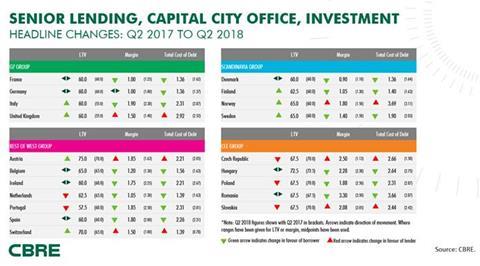New research from CBRE shows that credit conditions in the wider economy have generally eased in the last 12 months, with an analagous positive trend in real estate debt markets.

CBRE’s latest European Debt Map analyses commercial property lending data for 20 countries across the Continent to end Q2 2018, focusing on the office, retail and logistics sectors.
The report's pan-European findings use the largest, most liquid sector - offices - as a proxy for trends across the whole market.
Over the last 12 months, senior LTVs in prime office lending have risen in seven countries, stayed flat in eight, and fallen in five. Meanwhile, senior margins have fallen in 13 countries, but risen in only six.
Falling margins
'Our data suggests that the lending climate has become more attractive to borrowers over the last 12 months, with LTVs generally staying flat or rising and margins largely falling for senior lending on offices,' said Paul Coates, head of debt and structured finance Europe at CBRE.
'Lenders are facilitating healthy levels of transactions, but may increasingly become wary of falling margins and rising pressure on LTVs – particularly given the historic levels of capital growth now incorporated into current values – and engage further prudence in section markets, assets and borrowers with which to engage,' he added.
According to the data, total cost of senior debt has declined in 14 countries, but increased in just six.
Rising LTVs
Taking an average of the 20 European countries included in the analysis, LTVs have risen to 64.25%, up from 63.25% a year ago, while margins have fallen from an average of 1.74% to 1.67%. That means the average total cost of debt has fallen from 2.20% to 2.17%.
The data highlights a general shift towards cheaper debt at stable or increasing LTVs, particularly in the main European markets of Germany, France and Italy – though not the UK – and many of the smaller western European and Scandinavian markets.
In the UK, while LTVs have increased, margins have also edged up, highlighting a greater degree of caution from domestic lenders compared to their continental counterparts, the report concludes.










